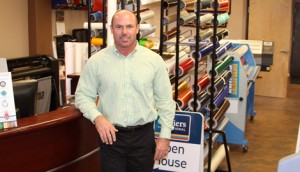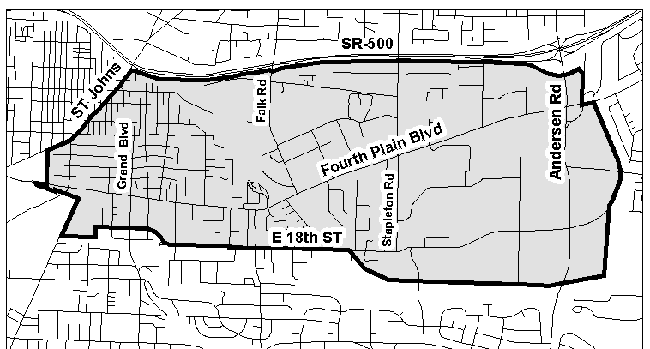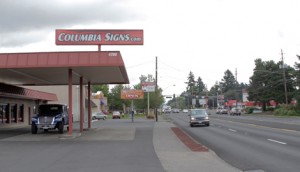Vancouver business owner Cody Reich is frustrated.
Four years ago, the owner of Columbia Signs moved his business from Burnt Bridge Plaza to his current location, a one-acre commercial plot at 4700 E. Fourth Plain Blvd. He liked the spot specifically because it would increase drive-by customers.
Reich, 38, spent $100,000 remodeling a dilapidated auto repair shop and removing seven large underground fuel tanks. He even donated a section of his land for a community garden.
“I wanted to find a property in an area to improve,” said Reich, who has owned Columbia Signs for 15 years. “I needed to have more of a drive-by availability to our customers.”
Now Reich would like to lease an unused section of his property to bring new business to the block. Earlier this year, he was close to working out a long-term lease agreement with Vancouver entrepreneur Brian Magnussen to bring a Human Bean drive-up coffee franchise next door to Columbia Signs. Magnussen estimates the project would have generated $200,000 in new construction work, created six to eight jobs, and provided a new service to the neighborhood. All good things, right?
Not so fast.
As part of a comprehensive vision for the Fourth Plain corridor, the City of Vancouver no longer allows drive-through lanes such as those needed for The Human Bean’s coffee window in that section of Fourth Plain. Plus, codes also require all new storefronts within the so-called Fourth Plain Overlay District to be no more than 12 feet from the sidewalk, something the architecture of the Human Bean building couldn’t accommodate.
Reich and Magnussen asked the city for an exception, to no avail. Magnussen had to walk away and search for another site. He said he has nothing against the city using zoning strategically, but he feels the Fourth Plain Overlay District is too generalized and is having repercussions that city planners didn’t anticipate.
“I’m not insensitive to what the building department is trying to do,” he said. “You should allow for smart growth. [However], if the rule has side effects and you are not flexible, you’re not giving us freedom.”
To make matters worse for Reich, he’s spent in the order of $20,000 for various engineering studies to make his property “shovel ready” for new development. Prior to the Human Bean project, Reich wanted to add two new buildings to the site to open more retail space. But that would have meant major street improvements, including the placement of a median in the street to prevent east bound drivers from turning left into his property. Estimates for that approached $300,000.
“[The city’s] goal is to get me to redo 200 feet of road and sidewalk,” he said. “It also stops the turn access, which makes it harder for me to do business. I’m paying to limit my access and business.”
As a result, Reich has scaled back his ambitions and currently only wants to add a 750-square foot addition to his existing building so he can increase his staff from five to seven employees. Nonetheless, he would still need to widen the sidewalk in front of his store and install landscaping per city specifications.
Reich says the city is impeding his ability to lease his property or expand his store, effectively thwarting economic development, not enhancing it.
“When improvements are made to properties, it’s their opportunity to force the owners, the developers to make the adjustments, whether it be codes or design standards,” said Reich. “They’ve limited what we can develop to try to improve the area. It’s stopping business from doing businesses.”
In 2007, the Vancouver City Council approved the Fourth Plain Corridor Subarea Plan (FPCSP) in an effort to revitalize a large swath of central Vancouver bordering St. John’s Boulevard to the west, State Route 500 to the north, Burton Road to the east, and 18/20th street to the south. The subsequent overlay district established the code requirements to ensure that future development was consistent with the plan.
The FPCSP seeks specifically to transform a 2.5-mile stretch of Fourth Plain into a pedestrian-friendly streetscape replete with trees, continuous sidewalks, and retail businesses close to the street. The overall goal is to create a corridor that is safer, more economically viable, with a wider range of housing and employment opportunities.
Currently, sections of the Fourth Plain corridor face chronic crime, a high percentage of rental units (70 percent of housing, as of 2006), and a median household income that is 40 percent lower than the rest of the city.
“The plan provides more consistency in the look and feel of the corridor,” said Bryan Snodgrass, a principal planner in Vancouver’s Division of Long Range Planning. “The general thinking is … it would take some time for benefits to improve it, but it would ultimately make for a more viable corridor.”
Proponents of the Fourth Plain plan understand that some business owners will find the FPCSP restrictive, but they add that it is still the right approach for enhancing a sense of community along the corridor.
“Walkable communities are the heart of healthy communities,” said Rose Village Neighborhood resident Mark Maggiora. “[Fourth Plain] is like a mini-highway in some places. It is not a place where you want a mom and a stroller with two kids on bikes going, but some have to do that.”
Maggiora, 56, is the executive director of the community development corporation Americans Building Community, Inc. and is active with the Fourth Plain Merchants Association. He says there was considerable community input in the creation of the plan, particularly from Fourth Plain business owners who’d like to see resources invested in the corridor right away.
Maggiora wants the city to be responsive to the concerns of business owners, while not watering down the impact of the overall plan.
“The goal is to minimize the damage and maximize the good,” he said. “There are elements of that plan that are in conflict with one other. You have to take that into consideration. But it’s a slippery slope. When you start making accommodations for one entity, someone else will want a break.”
Laura Hudson, Vancouver’s community development director, said the situation along Fourth Plain is complicated by the fact the city can’t afford to initiate the considerable street work the subarea plans calls for. However, any private developers bringing new or significant remodeling projects to the corridor will still be responsible for improvements to their street frontage.
Hudson said the city is offering a new program that will allow businesses that can’t – or won’t – pay for road improvements at the present time to sign a covenant with the city and agree to pay their portion in the future.
“There are going to be some people who don’t want to spend the money on the public improvement; they want the least cost,” said Hudson. “The city is saying you have to meet certain basic public access and pedestrian safety access.”
Reich also wants to see a more economically viable Fourth Plain corridor, but not if the burden is put on the backs of small business owners like him. He wants to see more flexibility in the codes so that they don’t stifle what economic development is at hand, particularly in a down economy.
“[Fourth Plain business owners] are living under a different set of codes than the rest of the city of Vancouver and we’re at a huge disadvantage, not only in this market, but against someone who’s a mile down the street on a different business road,” he said. “It’s stopping me from hiring contractors, it’s stopping me from doing business, and it’s stopping me from hiring employees that will do business.”












